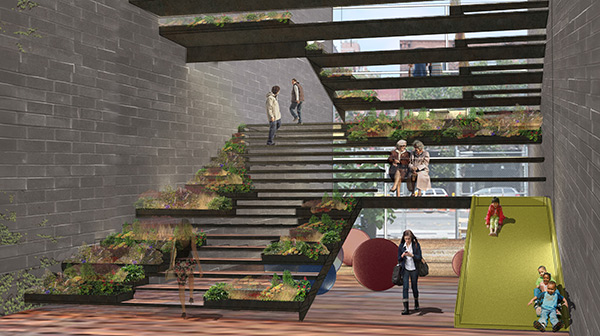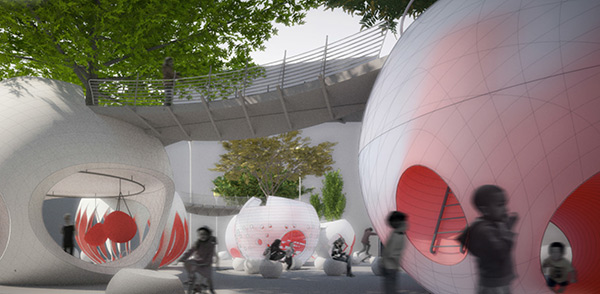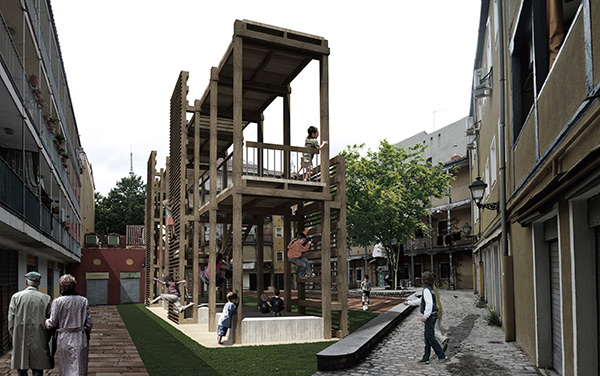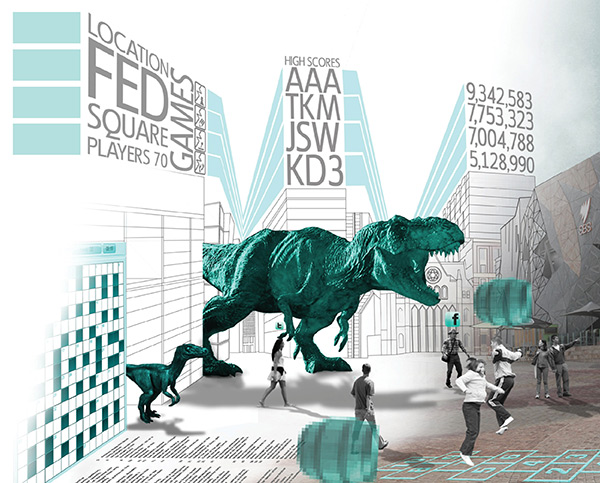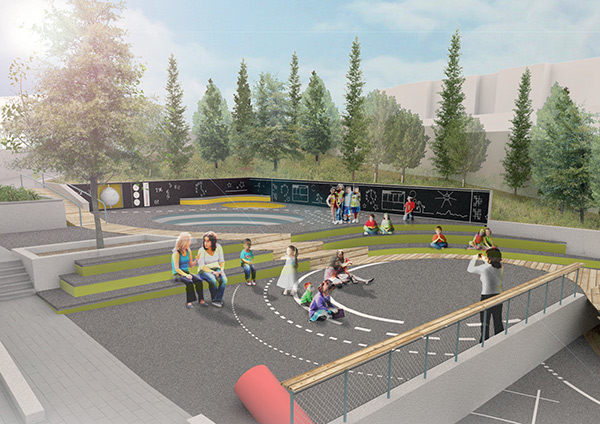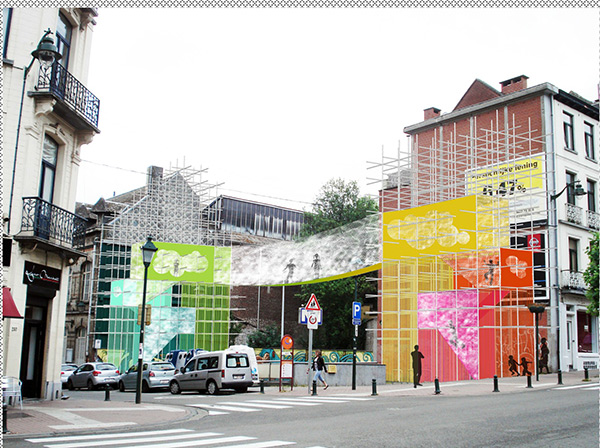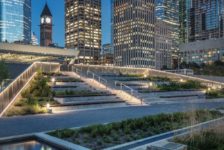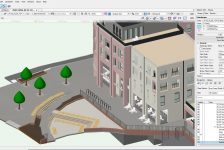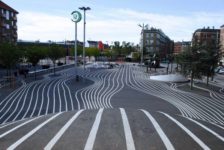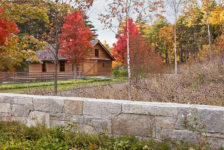Building Trust International has released the winners and honorable mentions for the PLAYscapes competition. In this Top Ten, we will be traveling to underused and undervalued areas from Melbourne to Mumbai and from Cape Town to Madrid to see how professionals have re-imagined these dark corners as places for play. 10. StairScape — New York, USA
Located on Bowery in the Lower East Side of New York City, a former asphalt yard is turned into a small, playful space. Stairscapes accommodates those who want to either rest or play, challenging traditional ideas of a city bench and a pocket park. It aims to be a “new civic space for all” that provides customers in adjacent shops with extra seating and a space for office workers to enjoy a relaxing lunch and break time, for families to enjoy their weekend together, and for the elderly to keep active and be a part of the community. 9. Plant-a-Ball Parks — New York, London, Paris… The Plant- a-Ball park is a creative entry that can be installed in any city in the world. With education and ecology in mind, the balls themselves define an empty space. They balance structural design with an organic form that allows for ecology to thrive while maximizing the growing imagination of young children. There are five balls, each with their own thriving habitat: butterfly, bird, amphibian, animal, and insect. Each has its own forms of play: slide, merry-go-round, climbing nets, pool, swings. 8. Coralla — Madrid, Spain Coralla is a lightweight and permeable device that works as a public playground and a tool for parking community engagement where children, teenagers, and adults are to be mixed visually and physically. Coralla is an adaptable structure that could be placed in many spaces. Made out of lightweight modular wooden and metal frame columns, the multi-levels support various forms of play, rest, bicycle parking, and can even function during the night as an outdoor movie theater! 7. Bom(PLAY) — Mumbai, India Incorporating the use of the huge water pipeline that stretches through the middle of Mumbai, Bom(PLAY) proposes to turn the long, green corridor into a play corridor. The project cleverly uses the existing pipeline structure to allow for fun activities. The unique proposal shows the fun aspects of the city itself. Who knew a pipeline could be turned into a skatepark, an amphitheater, walkways, exhibition spaces, and picnic and Ping Pong tables? 6. POP-up PLAY house — Philadelphia, USA The project seems as playfully simple as the title — “Simply pick out the stencil, pop out the panels, line them up, connect the openings and inhabit.” Made out of 100 percent post-industrial wood and plastic-waste durable and waterproof panels, the pop-up playhouse attempts to be a place for learning and interacting with the architecture of Philadelphia. Varying from ground level to an elevated lookout, the in-between play spaces encourage children to “inhabit” the space and create their own history. 5. Urban Zipline — London, UK Do you dare to zipline off a chimney? Urban Zipline uses chimneys left redundant from the industrial revolution as a way to bring life into the neglected industrial site and turn it into a lively green space. Users get the chance to view the bustling city of London from above, flying along the city skyline. This zipline is aimed at attracting more activities in the green space below. There is even an aspiration to fly from a neglected chimney above the city’s rooftops before landing on a roof terrace of a building! 4. Celoscape — Melbourne, Australia Celoscape creates a virtual world of games for smartphone users to turn any place into a play space. The project can be as fun as the player makes it to be. Using the latest Augmented Reality Technology with a smartphone camera and Image Recognition Software, Celoscope superimposes “graphics, audio and other sensory enhancements over the real world environment in real time while utilizing the smartphones’ GPS capabilities to locate and discover new areas to play.”3. The Bridge of Co-existence — Jerusalem
In hope of bringing together the Jewish and Arab children of Jerusalem to teach them the value of coexistence in a mixed neighborhood, the project targets an empty schoolyard that serves as a gathering and play space for local children. The bridge physically connects five different areas: learning, gathering, treehouse, sport, and playground, which are all designed for the specific needs of the community. 2. Parkour (in) the Sky — Brussels, Belgique The project offers an alternative vertical adventure for children right outside the historical center of Brussels. It uses two gables where climbing nets, bouncy rubber mats, and a rope bridge allow for a journey that evokes “adventurous walk in the sky, through colorful clouds and rain.” 1. Mill St. Skatepark — Cape Town, South Africa The winning project entry for PLAYscapes has an aim to shift the misconception of skateboarders, providing them with a harmonious, dedicated space that allows them to practice their sport without clashing with other users. Roads bound the cleverly chosen site in Cape Town, so noise pollution from the sport will not be a problem. The winning team entrant Gerrit Strydom states how the proposal stands as a testament “to the importance and value of the broader dialogue about the abundant opportunities for activating difficult public spaces for the benefit of diverse set of users.” These entries make us aware that fun can exist in any corner of the world through any medium of creativity. Competitions like PLAYscapes allow designers to stretch their imagination in the most simplistic to complicated ways, and this definitely is illustrated in the entries. Building International Trust will continue its mission of tackling real-world problems through design, combining place-making with the benefit of humanity. As landscape architects, we can continue to get involved in providing some of these answers. Congratulations to the project team from the City of Cape Town! Look out on the website for the next competition; let’s see what issue can be tackled next! Article written by Win Phyo Published in Blog


